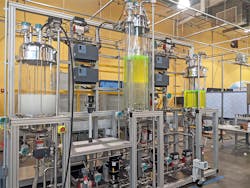Siemens and Dow recently unveiled and demonstrated a new process industry testbed during a ribbon-cutting event at MxD, a state-of-the-art advanced manufacturing institute and innovation center in Chicago. The testbed uses internet of things (IoT) enabled hardware to generate a digital twin of physical assets that can enable real-time production monitoring, predictive maintenance, and the streamlined delivery of training materials to workers via augmented reality (AR) headsets. While similar technologies have been demonstrated in the past, Billy Bardin, Dow’s global digitalization director, says the testbed at MxD will put this approach into practical use to accelerate commercialization.
By modeling the plant floor virtually, digital twins can help determine how workers will interact with equipment before construction or renovation of a facility has even begun. As a result, factories can be virtually commissioned and workers can begin training for their new roles well in advance of real production. Simply put, not only is the time it takes to commission a factory reduced, but once the physical facility opens, a well-trained workforce can already be available to step in and get to work.
Once a facility is fully-staffed and operational, digital twin data delivered via AR can be used to expedite ongoing maintenance, repair, and operations procedures as well. According to Bardin, as much as 80% of the time consumed by these tasks is spent simply finding the right information to diagnose a problem or consulting schematics and diagrams.
By contrast, when using an AR headset, workers only need to look at a given part or component to trigger the headset’s software to deliver relevant schematics and instructional materials instantaneously. From there, a 3D representation of the part or component and the tasks that need to be performed on it are superimposed over users’ field-of-vision. Audio-visual remote assists, which allow subject matter experts to highlight, circle, or otherwise emphasize specific details, can also be incorporated into the information delivered to the headset wearer.
These functionalities are all provided through Siemens’ web-based Simatic PCS Neo process control system, which grants users across various locations a single source of information that is continuously updated in real-time. Via Simatic PCS Neo, total virtualization of both the control system and physical assets can be provided, allowing end-users to run simulations of various production system operations.
“Providing this hands-on experience [at the testbed] will be critical for digital transformation in the process industries, showing how the digital twin and the connected mobile worker can enable greater productivity, reliability, and safety,” Bardin says.
According to Raj Batra, president of Digital Industries for Siemens USA, the various technologies exhibited by the testbed can help speed time-to-market as manufacturing operations reshore in response to global supply chain disruptions. “Digitalization is rocket fuel for manufacturing,” he says.
About the Author
David Miller
Former Senior Technical Writer

Leaders relevant to this article:
